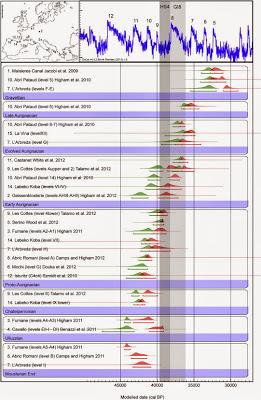Source - http://dienekes.blogspot.fr/2014/04/chronology-of-earliest-upper.html

From a press release:
The main conclusion -"the scene of the meeting between a Neanderthal and a Cro-magnon does not seem to have taken place on the Iberian Peninsula"- is the same as the one that has been gradually reached over the last three years by different research groups when studying key settlements in Great Britain, Italy, Germany and France. "For 25 years we had been saying that Neanderthals and early humans lived together for 8,000-10,000 years. Today, we think that in Europe there was a gap between one species and the other and, therefore, there was no hybridation, which did in fact take place in areas of the Middle East," explained Arrizabalaga. The UPV/EHU professor is also the co-author of a piece of research published in 2012 that puts back the datings of the Neanderthals. "We did the dating again in accordance with the ultrafiltration treatment that eliminates rejuvenating contamination, remains of the Mousterian, the material culture belonging to the Neanderthals from sites in the south of the Peninsula. Very recent dates had been obtained in them -up to 29,000 years- but the new datings go back to 44,000 years older than the first dates that can be attributed to the Cro-Magnons," explained the UPV/EHU professor.
Journal of Human Evolution Volume 69, April 2014, Pages 91–109
The chronology of the earliest Upper Palaeolithic in northern Iberia: New insights from L'Arbreda, Labeko Koba and La Viña
R.E. Wood et al.
Since the late 1980s, northern Iberia has yielded some of the earliest radiocarbon dated Aurignacian assemblages in Western Europe, probably produced by anatomically modern humans (AMHs). This is at odds with its location furthest from the likely eastern entry point of AMHs, and has also suggested to some that the Châtelperronian resulted from cultural transfer from AMHs to Neanderthals. However, the accuracy of the early chronology has been extensively disputed, primarily because of the poor association between the dated samples and human activity. Here, we test the chronology of three sites in northern Iberia, L'Arbreda, Labeko Koba and La Viña, by radiocarbon dating ultrafiltered collagen from anthropogenically modified bones. The published dates from Labeko Koba are shown to be significant underestimates due to the insufficient removal of young contaminants. The early (c.44 ka cal BP [thousands of calibrated years before present]) Aurignacian chronology at L'Arbreda cannot be reproduced, but the reason for this is difficult to ascertain. The existing chronology of La Viña is found to be approximately correct. Together, the evidence suggests that major changes in technocomplexes occurred contemporaneously between the Mediterranean and Atlantic regions of northern Iberia, with the Aurignacian appearing around 42 ka cal BP, a date broadly consistent with the appearance of this industry elsewhere in Western Europe.